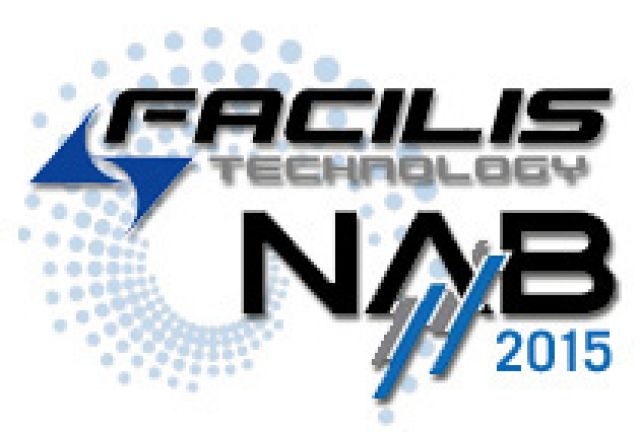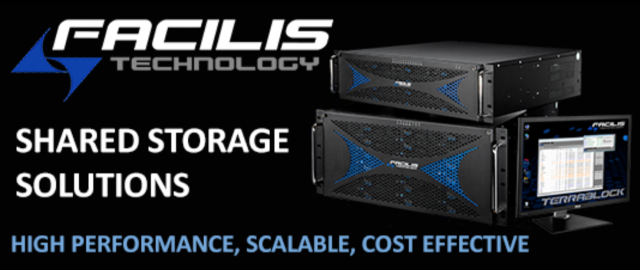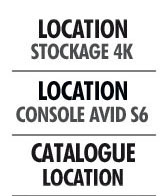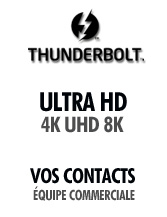 Facilis Technology était présent au NAB 2015 stand SL8811. Fabricant de stockage centralisé SAN à forte bande passante avec attachements mixtes (Fibre 8 et 16 GB et Ethernet 1 et 10 GB) Facilis Technology a dévoilé les dernières mises à jour de son file system. Pour rappel, CTM Solutions importe et distribue en France l'ensemble de la gamme des produits Facilis Technology, en vente et en location
Facilis Technology était présent au NAB 2015 stand SL8811. Fabricant de stockage centralisé SAN à forte bande passante avec attachements mixtes (Fibre 8 et 16 GB et Ethernet 1 et 10 GB) Facilis Technology a dévoilé les dernières mises à jour de son file system. Pour rappel, CTM Solutions importe et distribue en France l'ensemble de la gamme des produits Facilis Technology, en vente et en location
Join us at NAB 2015 (booth SL8811) as we showcase new products along with significant innovations to our current terraBlock shared storage system. We will be demonstrating scale out features for larger work groups, integrated asset tracking, improved interoperability with third party products and performance enhancements for resolutions iindependent workflows.
Article en lien avec Facilis Technolgy :
Scale-out 4K+ collaborative workflow – it's here, are you ready? That knock you hear on the door could be opportunity or doom "The picture looks great," uncle Bernie comments while perusing big screens at the appliance store, "but next week they'll have Super UHD, then this TV is obsolete!" Those comments represent some of the most pressing problems... sorry, opportunities that face the content creation industry today. How do you acquire, post and deliver with a method that will produce content suitable for years to come, with infrastructure and equipment originally specified for use with outdated formats ?
 Let's take Boyhood, the recent film with a 12-year production schedule, shot entirely on 35mm. Of course, there wasn't much of a choice in 2002. What if production started today? The long-term benefit of higher resolution is obvious – down-res for today's delivery, while maintaining a quality master for future up-res. Yes, you will be up-resing 4K. I recently viewed an 8K display at Inter BEE in Japan, connected to a live feed from an Ikegami camera. Digital reproduction was amazing, and reminded me of the time I first saw HD 1080 on display in '95. Adding on to the clarity inherent in huge pixel sizes, advancements in frame rate and color space will push the state of the art to new levels in the coming years.
Let's take Boyhood, the recent film with a 12-year production schedule, shot entirely on 35mm. Of course, there wasn't much of a choice in 2002. What if production started today? The long-term benefit of higher resolution is obvious – down-res for today's delivery, while maintaining a quality master for future up-res. Yes, you will be up-resing 4K. I recently viewed an 8K display at Inter BEE in Japan, connected to a live feed from an Ikegami camera. Digital reproduction was amazing, and reminded me of the time I first saw HD 1080 on display in '95. Adding on to the clarity inherent in huge pixel sizes, advancements in frame rate and color space will push the state of the art to new levels in the coming years.With all of this in mind, are you ready? Even the very traditional offline and craft edit facilities that pride themselves on the quality of the storytelling, have moved to lower compression and higher resolutions to satisfy their clients who want to see the beauty of the images all the way through post. In 2015, that beauty is represented with 4K or UHD (2160p), but many people reading this will have already been involved in 6K shoot and post. One of our customers in NYC was recently involved in a 6K RED multi-cam production, posted and finished with raw camera files all the way through. Yes, 6K raw multi-cam, no transcoding, no waiting.
James McKenna de facilis technolgy
So, what does it take to build a facility that can take on these new workflow challenges? Retooling your client workstations is easier than ever. The commoditization of capture and display hardware, some of which is developed for gaming applications, has resulted in a huge leap forward in the cost-effectiveness of high-resolution image display on standard PC and Mac workstations. Good 4K display screens are constantly coming down in price, and will continue to do so for the foreseeable future. Of course, color-calibrated reference monitoring is still a pricy proposition, still in the $1000/inch range, just like it was 10 years ago. Luckily, when discussing scale-out 4K post, that's not a required component.
So that leaves the infrastructure – most notably, storage networks. We don't have to get into the metrics of file sizes and speeds of access that 4K post requires, but let's just say that without a plan, you're going to wedge up a standard network topology in a matter of minutes. So, you have two choices. Develop a strong back, so you can lift and carry HDDs around the edit suites all day, or develop a strong network backbone, to handle the requirements of real-time access from multiple workstations. We suggest the latter, and we have some suggestions on how that's done.
In the same way that a video clip that starts out in pristine 1080i and winds up on YouTube, you have to start with the best to achieve the acceptable. The storage array or SAN server should benchmark much faster than you need it to be, because that performance will degrade as more and more users log on. Never take the word of a salesman who gives you a MB/sec performance number for a server, and tells you to "do the math", to get the number of video clients that it can support. You'll find yourself buying more disks in short order. Manufacturers that dedicate themselves and their products to the business of content creation will specify a number of streams (video files) that can be played in real time, without stopping or dropping frames, on a given size server. This takes into consideration the degradation of performance inherent with scale-out workgroups. Without this, you're flying blind.
If the video streams are acceptable for what you need, next you'll need a way to get all that data in and out – the backbone of your facility. Fibre Channel has long been a favorite connectivity method for post-production, because of the ease of use, reliability and maintenance-free operation. Ethernet has always been the scale-out choice because of ubiquity, low cost and accessibility of components. The convergence of IT and production has led to network hardware providers that focus on content creation market. 10Gb Ethernet can be as fast as Fibre Channel in some applications, and there are dozens of switch manufacturers after your business. However, Fibre Channel still enjoys a place in thousands of facilities, and in many cases the infrastructure in place can easily support upgrades in speed, all the way up to 16Gb/sec.
An easy way to traverse this conundrum is to investigate a storage solution that supports both connectivity methods – Fibre Channel for existing infrastructure and ultra-high bandwidth, and Ethernet for scale-out. The connectivity gives you the potential for bandwidth, but it's the exposure of the storage to the client that is often the determining factor of success. Ethernet-only NAS (Network Attached Storage) solutions use file systems developed for IT (Microsoft) use. These file systems are great at providing access to hundreds of clients on a single mounted network volume, but they're not very good at pushing large amounts of data from any one of them. The server side of that relationship is great at accepting requests from hundreds of clients concurrently, but isn't great at delivering the data with the low latency required by real-time playback clients. So, like getting a car to fly, it's possible, but a lot of extras and add-ons have to be applied.
Shared File Systems developed for content creation, by people who know the requirements of content creation are shaped more like a plane than a car, so it's easier to get them off the ground. By extracting all of the overhead required by standard network file systems and developing better methods of data manipulation, custom shared file systems enable more performance in a smaller form factor. By keeping the user experience simple, and adding features that streamline the process of sharing data among multiple workstations, custom shared file systems enable more productivity. Facilis Technology is a leader in 4K shared storage for post-production, and TerraBlock is the culmination of over 10 years' development in high-performance workflow enabling technology. That's opportunity knocking.
Source : article broadcastbeat.com
| < Précédent | Suivant > |
|---|




















